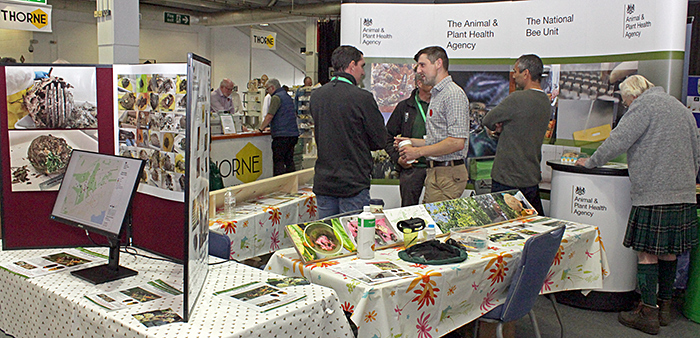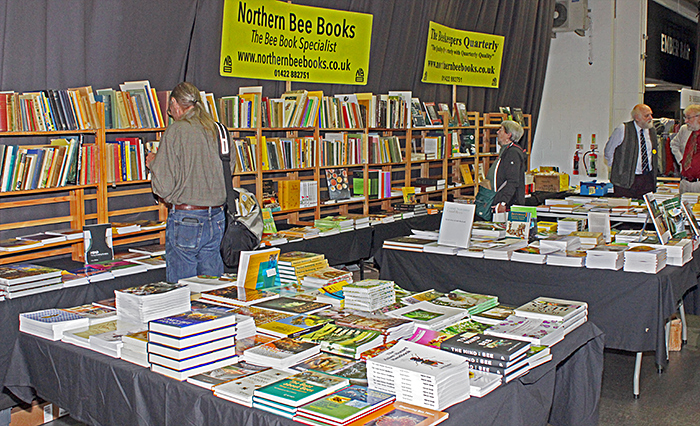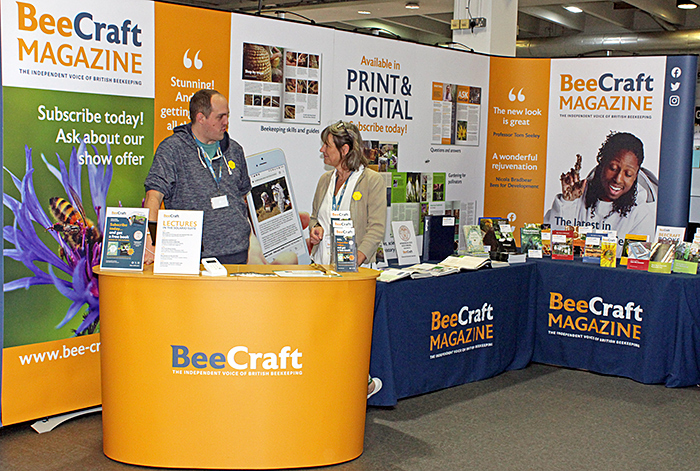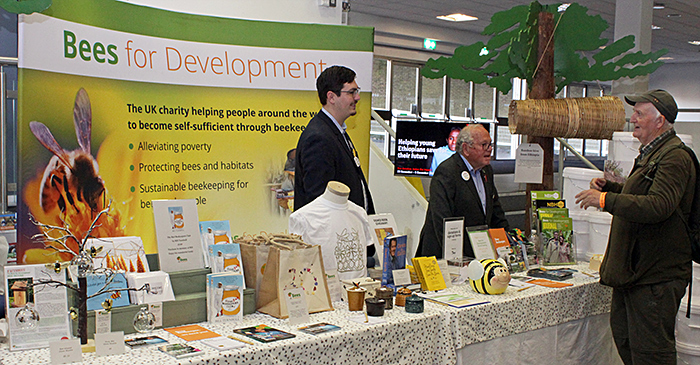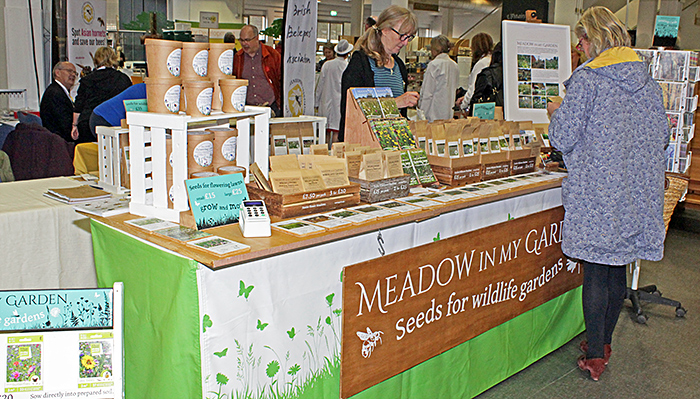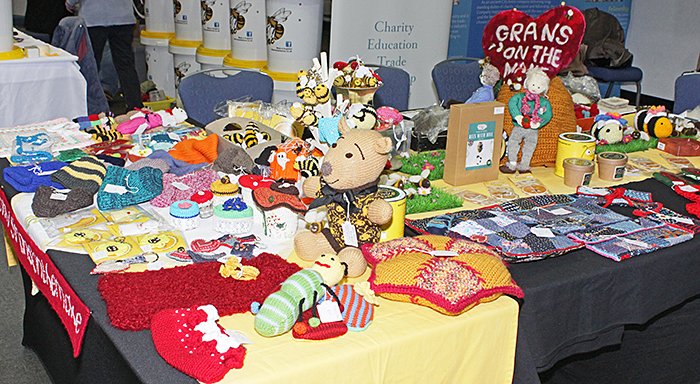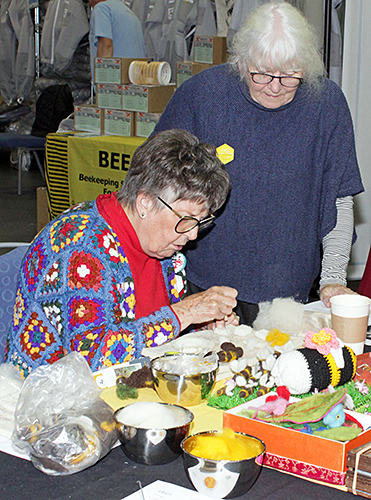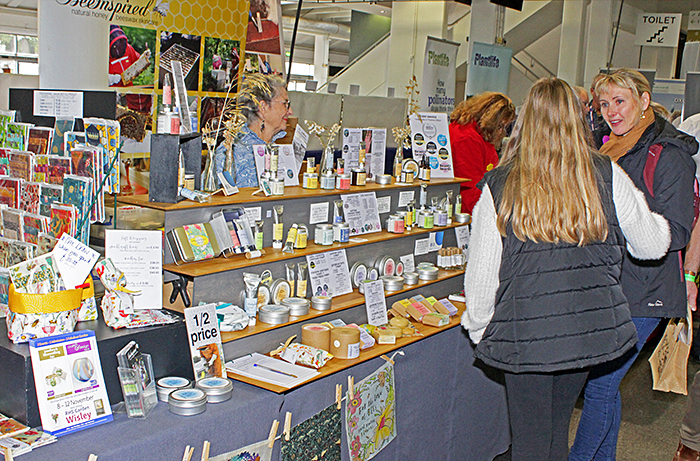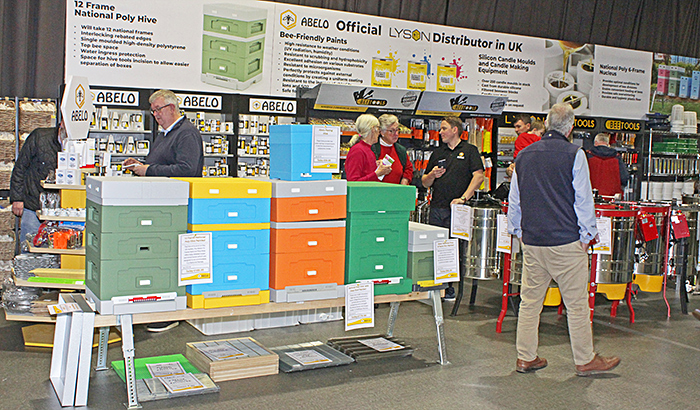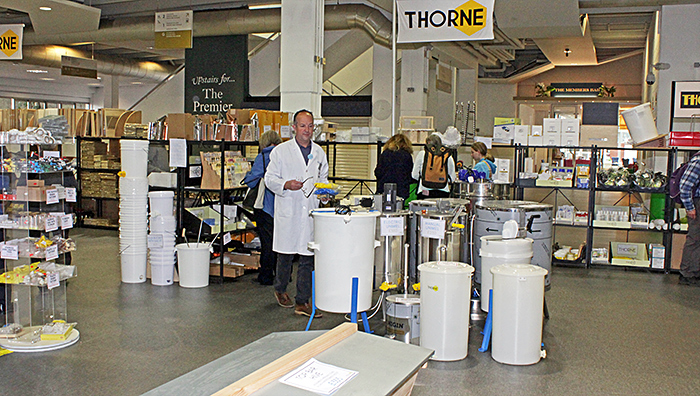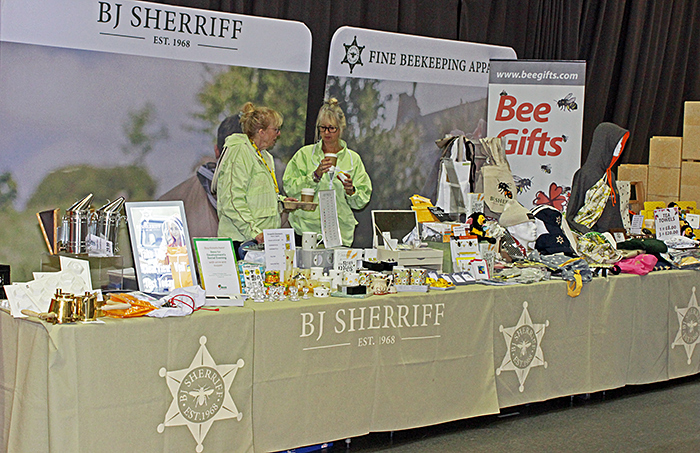National Honey Show
Thursday 26th to Saturday 28th October 2023
This was our tenth visit to the National Honey Show, held this year at Sandown Park Racecourse in Esher in Surrey, which has become a regular part of our microscopy outreach programme.
Gordon Brown, Pam Hamer, Paul Smith, Peter Sunderland and Alan Wood manned the Club’s stand in the Trade Hall, which is adjacent to the area where all of the entries for the Show are displayed. We had a good selection of specimens, microscopes and leaflets on the stand, a laptop computer with rolling PowerPoint presentations, and demonstrations of mounting pollen in LOCA and photomicrography with a tethered camera.
On Thursday, Pam and Alan brought stereomicroscopes, some prepared slides of pollen and honeybee anatomy, and some insect specimens. Pam brought a modern Brunel MX1 stereomicroscope that provides magnifications of 10× and 30× when used with 10× eyepieces. For comparison, she also brought an old Vickers stereomicroscope that provides magnifications of 8.75×, 35× and 70× when used with 7× eyepieces. The image quality was close, but the old Vickers provided the better images. Neither of them has built-in illumination, so Pam used flexible LED lamps connected to a powerbank. Pam brought some dead insects that she had collected so that we could examine them under the microscopes, and one of them turned out to be a hover fly that mimics a honeybee. The National Bee Unit lent us an Asian hornet (Vespa velutina) preserved in alcohol.
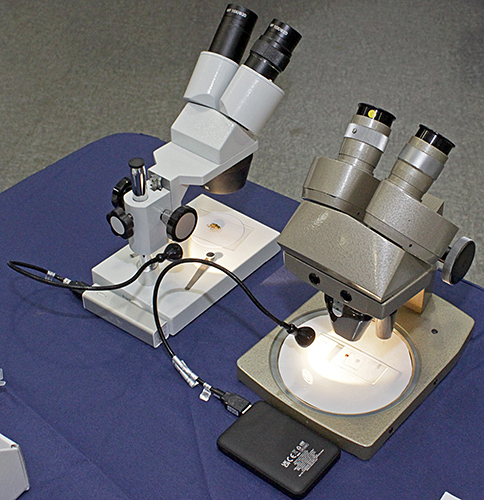 Pam Hamer’s stereomicroscopes
Pam Hamer’s stereomicroscopes
Alan brought his Olympus SZ4045 stereomicroscope, which provides a continuous range of magnification from 6.7× to 40× when used with 10× eyepieces. For illumination, he used an LED ringlight with variable intensity. Alan brought set specimens of a honeybee and a wasp (Vespula germanica), prepared slides of honeybee parts and pollen, and a photomicrograph of a single grain of mallow pollen (Malva sp.).
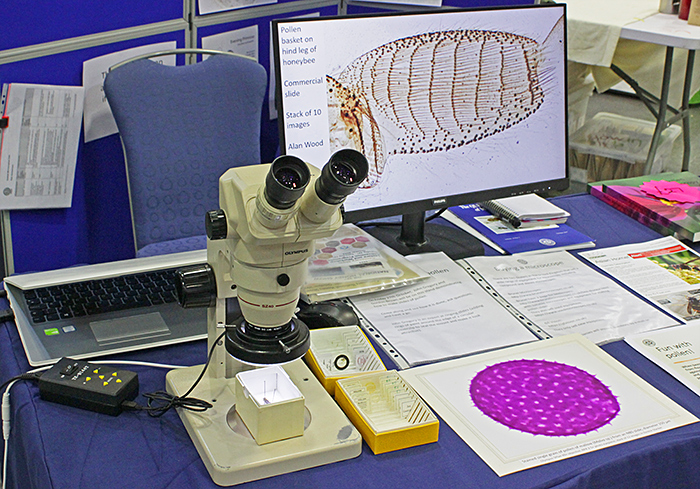 Alan Wood’s Olympus stereomicroscope
Alan Wood’s Olympus stereomicroscope
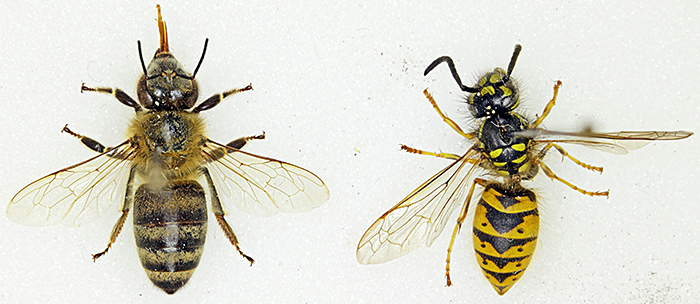 Honeybee and German wasp
Honeybee and German wasp
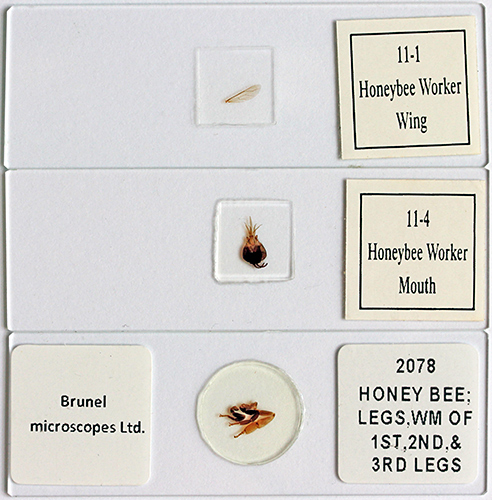 Slides of honeybee parts
Slides of honeybee parts
Alan also brought his laptop computer to show PowerPoint presentations of slides and photomicrographs taken by Quekett members.
Slide show: Honeybee anatomy, parasites and pollen
Click the arrows to move through the slides. Click the symbol at bottom right for a larger version.
On Friday, Gordon Brown brought his trinocular Olympus SZH stereomicroscope, which provides a continuous range of magnifications from 7.5× to 64× when used with 10× eyepieces, with an LED ringlight for incident illumination and a base that provides bright-field and dark-ground illumination. It was fitted with an Eakins FHD Camera V2.0 sending images via HDMI to a curved Acer monitor. Gordon used the Olympus to show some of the superb slides made by Peter Sunderland
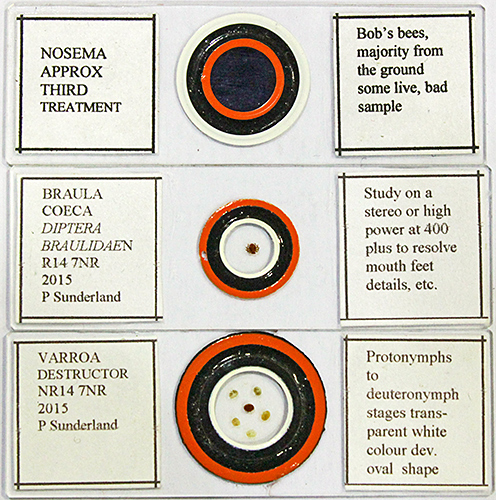 Some of Peter Sunderland’s ringed slides
Some of Peter Sunderland’s ringed slides
Gordon also brought his trinocular Leitz Dialux 20 EB compound microscope with objectives from 4× to 100×, providing magnifications from 40× to 1000× when used with 10× eyepieces. It was fitted with a Hayear camera and a 0.5× reducing lens, sending images via HDMI to a small Toguard D129 monitor. He used the Leitz to show slides of pollen stained with basic fuchsin and mounted in LOCA.
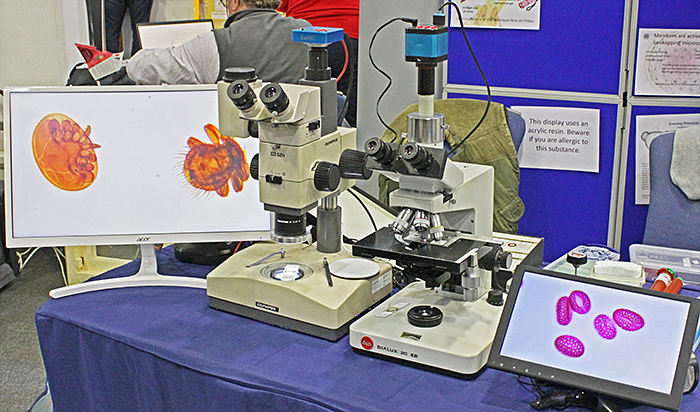 Gordon Brown’s Olympus and Leitz microscopes
Gordon Brown’s Olympus and Leitz microscopes
Gordon brought lots of pollen samples preserved in 100% isopropyl alcohol and stored in Eppendorf tubes. Throughout the day, Gordon showed how easy it is to transfer a pollen sample to a watch glass, stain with basic fuchsin, transfer to a slide, rinse with isopropyl alcohol, let the alcohol dry, add a couple of drops of LOCA, lower a coverslip onto the LOCA, and cure it for 90 seconds in a UV lamp that was intended for curing nail polish.
Gordon uses TP-2500 LOCA for pollen, and the runnier TP-1000 LOCA for legs and wings. He recommends soft plastic forceps for lowering coverslips onto slides, because it is impossible to press too hard and break the coverslip.
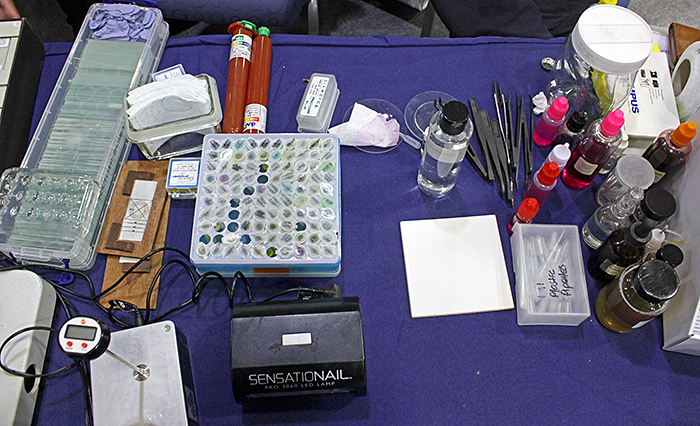 Gordon Brown’s LOCA mounting demonstration
Gordon Brown’s LOCA mounting demonstration
On Saturday, Pam brought her stereomicroscopes again, and Paul Smith brought his Tomlov DM602 digital microscope. This comes with three interchangeable lenses to provide a wide range of magnifications, and an accessory that provides transmitted light for viewing slides.
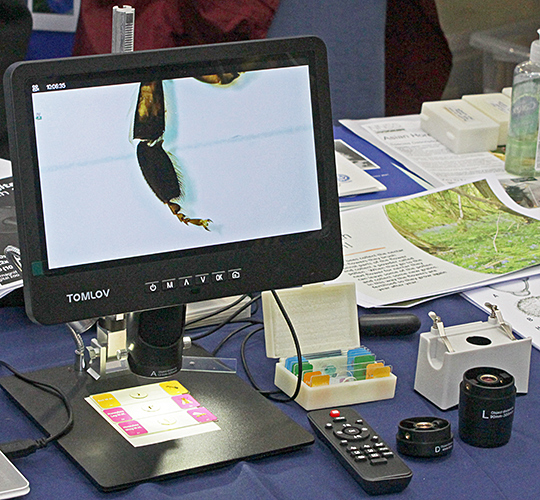 Paul Smith’s Tomlov digital microscope
Paul Smith’s Tomlov digital microscope
Alan brought his trinocular Olympus CH-2 compound microscope fitted with an NFK 2.5× photo eyepiece, a Photomicro Adapter L and a full-frame Canon EOS 5D Mark II digital SLR. The camera was tethered via USB to a laptop computer with the free Canon EOS Utility software. This allows images to be focused and composed on the computer screen, and exposure and white balance to be adjusted, so that there is need to touch the camera. Alan used commercial slides of pollen and sections of flower buds containing pollen that had been made by Quekett members Colin Kirk and Mike Smith, to show how easy it is to take good quality photomicrographs.
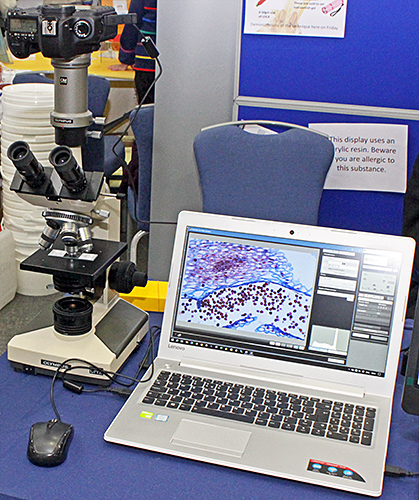 Photomicrography demonstration
Photomicrography demonstration
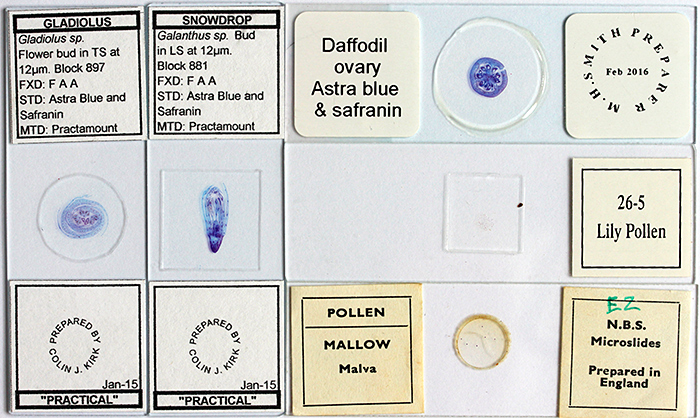 Pollen slides
Pollen slides
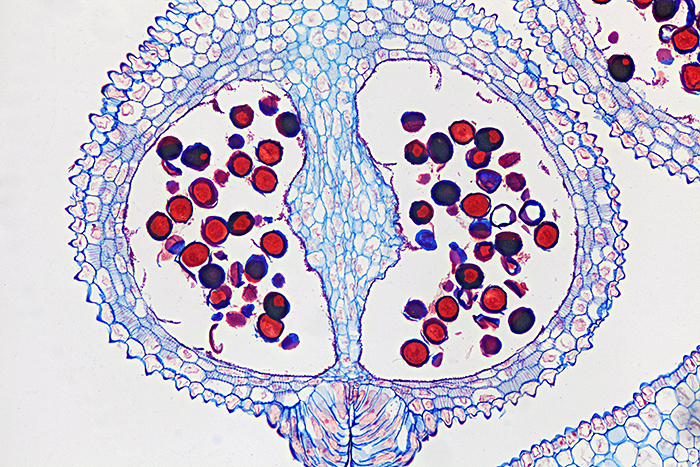 Pollen in flower bud of Gladiolus sp. (slide by Colin Kirk, transverse section, 10× objective)
Pollen in flower bud of Gladiolus sp. (slide by Colin Kirk, transverse section, 10× objective)
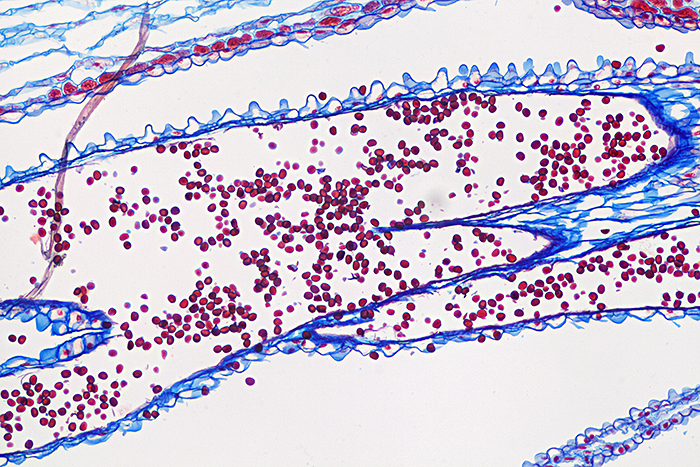 Pollen in flower bud of snowdrop (Galanthus sp.) (slide by Colin Kirk, longitudinal section, 10× objective)
Pollen in flower bud of snowdrop (Galanthus sp.) (slide by Colin Kirk, longitudinal section, 10× objective)
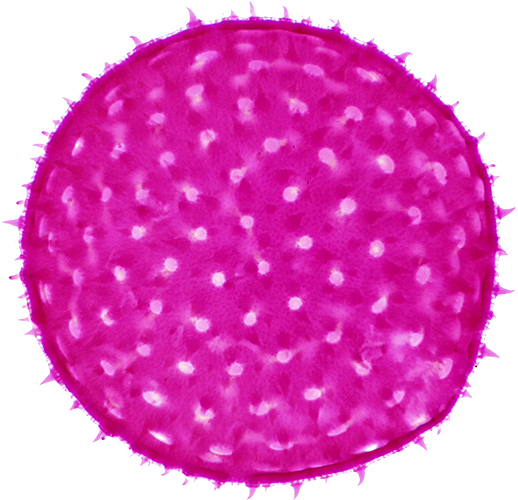 Pollen grain of mallow (Malva sp.) (slide by Eric Marson (N.B.S.), 40× objective)
Pollen grain of mallow (Malva sp.) (slide by Eric Marson (N.B.S.), 40× objective)
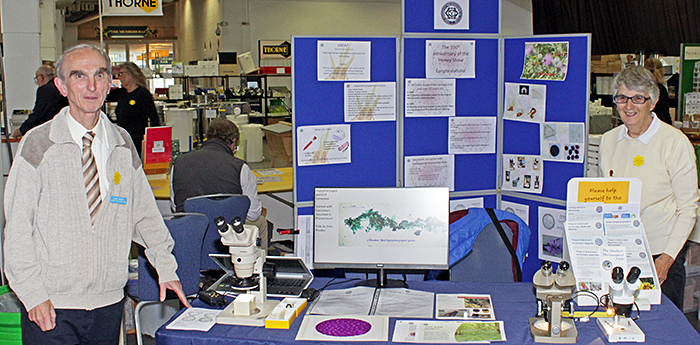 Alan Wood and Pam Hamer
Alan Wood and Pam Hamer
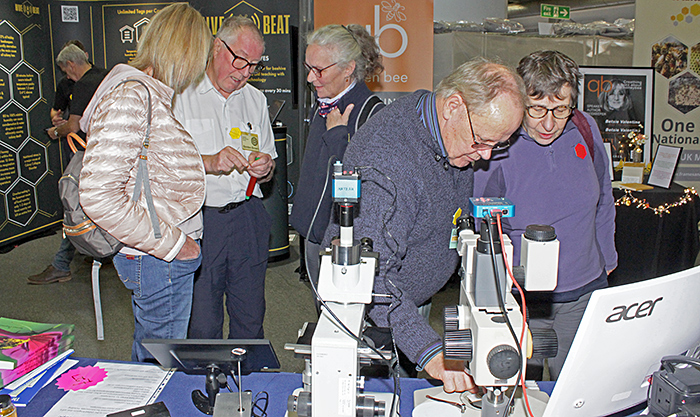 Gordon Brown and Peter Sunderland
Gordon Brown and Peter Sunderland
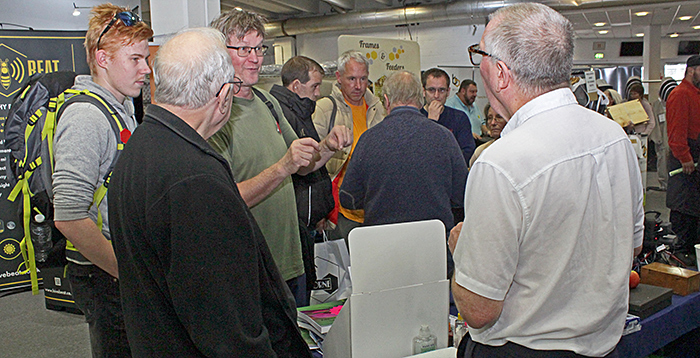 Crowd at the Quekett stand
Crowd at the Quekett stand
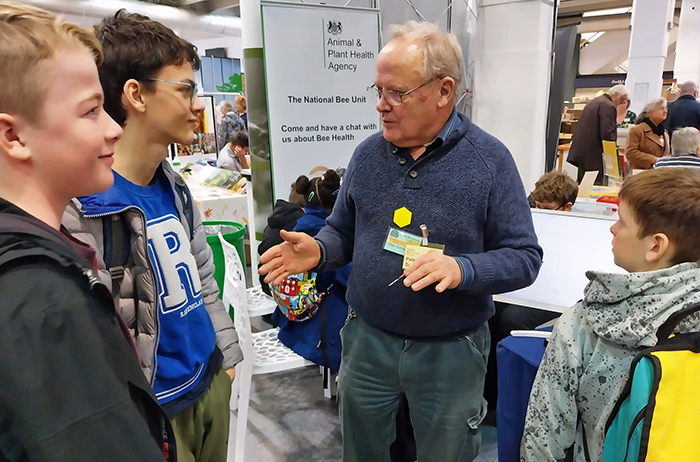 Peter Sunderland with members of Mrs Burney’s Bee Club CIC
Peter Sunderland with members of Mrs Burney’s Bee Club CIC
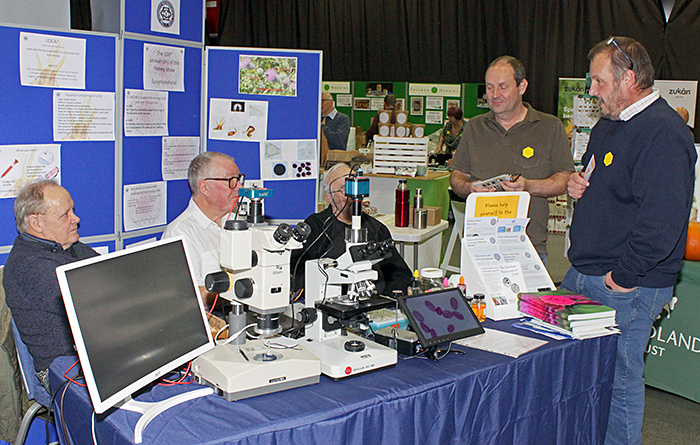 Peter Sunderland, Gordon Brown and Paul Smith (seated, left to right)
Peter Sunderland, Gordon Brown and Paul Smith (seated, left to right)
We gave away lots of copies of the Club’s leaflets on things to look at with microscopes (also available as free downloadable PDFs), and we were selling copies of Pollen Microscopy by Norman Chapman.
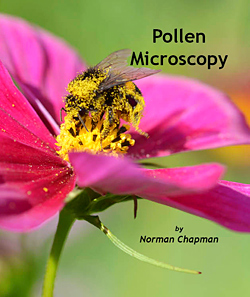 Pollen Microscopy, by Norman Chapman
Pollen Microscopy, by Norman Chapman
We had a lot of visitors, including Quekett members that we had not met before. We had some interesting conversations, often explaining the pros and cons of compound microscopes (high magnification, good for slides, but small working distance) and stereo microscopes (large working distance, good for dissecting honeybees, but low magnification). Several people asked about taking photographs through a microscope, and we explained that it can be done with a smartphone, a C-mount camera, an eyepiece camera, a point-and-shoot camera with a small zoom range, a mirrorless camera or a digital SLR. Our younger visitors did not ask this question, they just held their smartphones above the eyepiece of one of our microscopes.
Honey Show
The Show was in the same area as the Trade Hall, but cordoned off until late on Thursday afternoon while the judging was taking place.
There were thousands of jars of honey from large and small producers, all using the same style of jar.
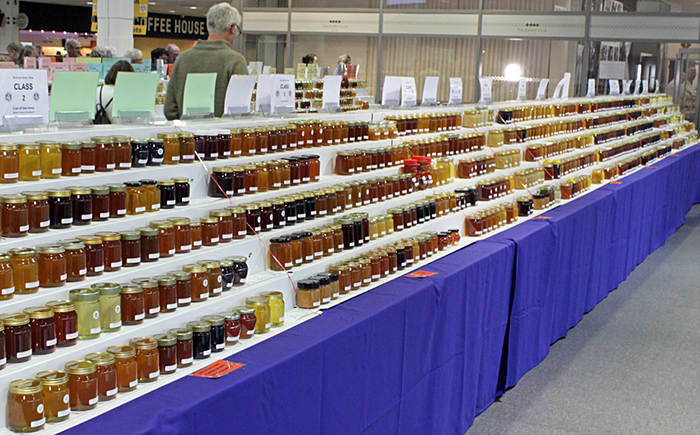 Jars of honey for judging
Jars of honey for judging
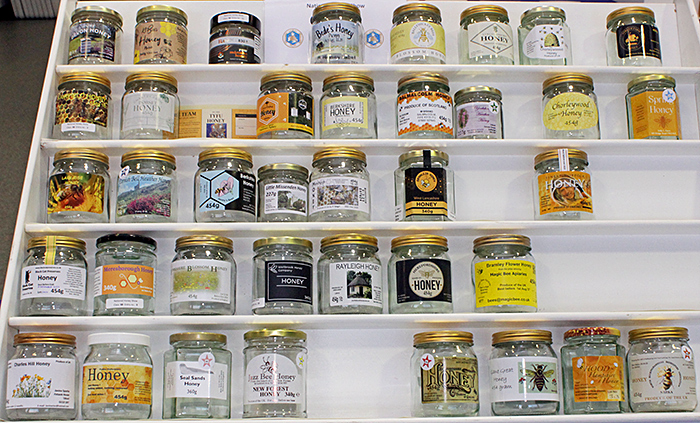 Honey labels for judging
Honey labels for judging
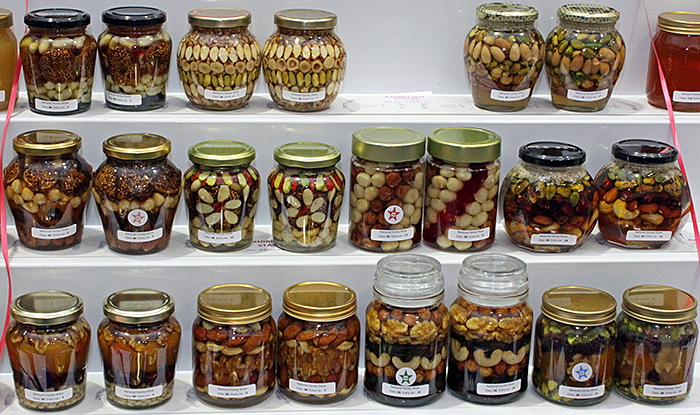 Honey with nuts for judging
Honey with nuts for judging
There were hundreds of bottles of mead (an alcoholic drink made from honey, yeast and water), displayed so that their colour could be assessed.
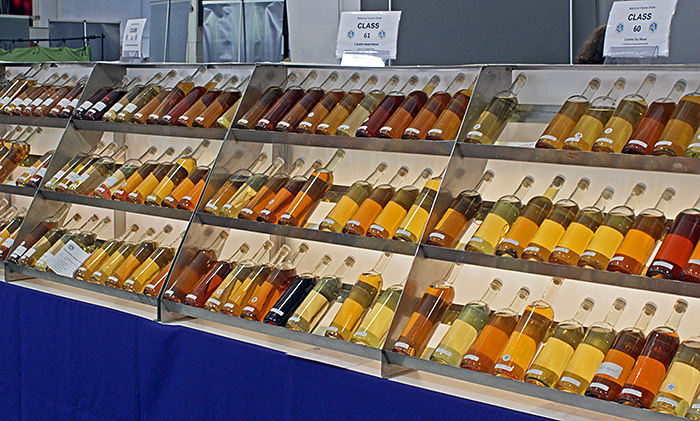 Bottles of mead for judging
Bottles of mead for judging
There were lots of candles and other fairly simple items made of beeswax, but there were also some amazing flowers made of beeswax, and even a beeswax chess set.
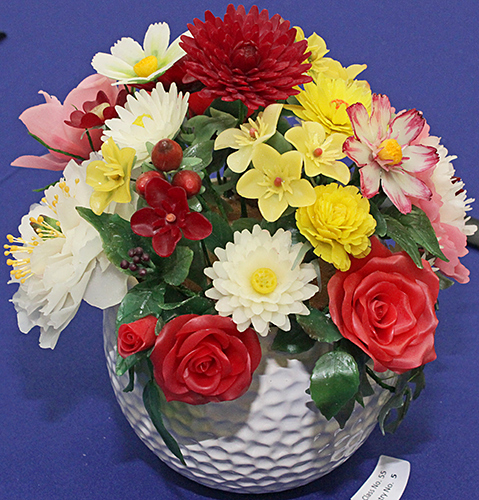 Beeswax flowers
Beeswax flowers
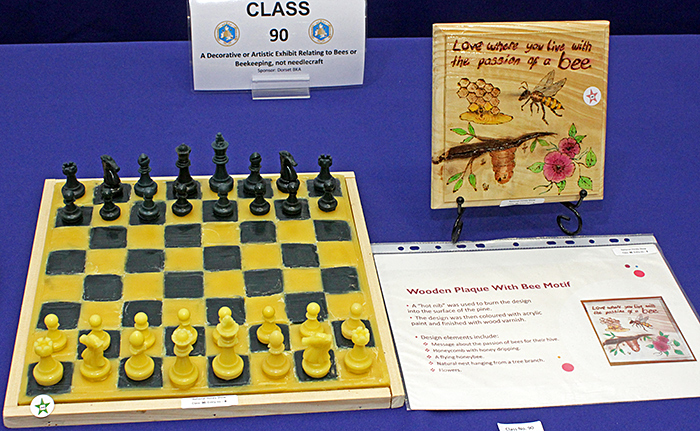 Beeswax chess set
Beeswax chess set
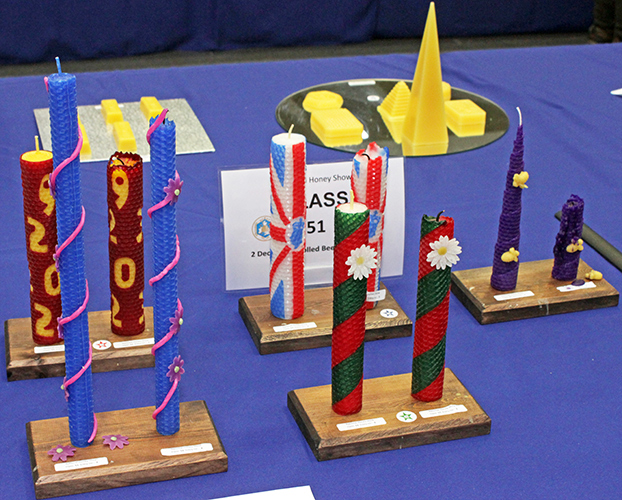 Coloured wax candles
Coloured wax candles
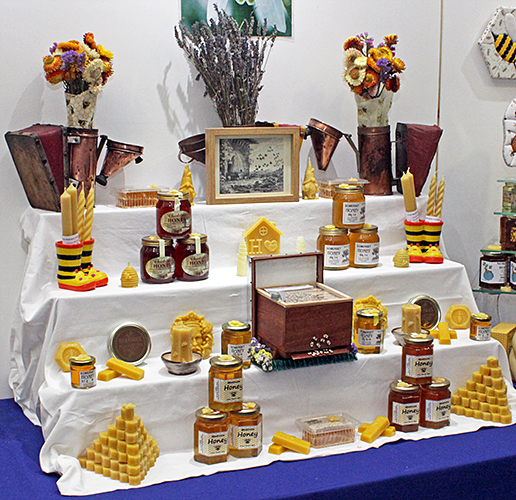 Shop window display
Shop window display
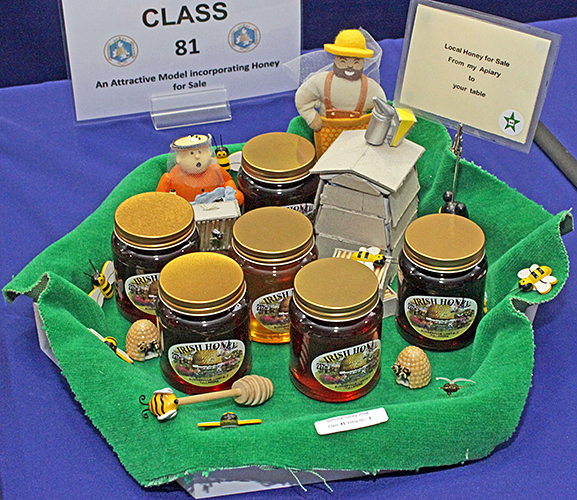 Honey for sale display
Honey for sale display
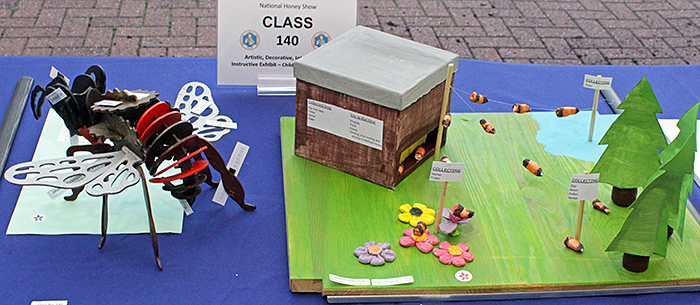 Entries from children
Entries from children
The categories also includes items of more interest to Quekett members: slides and photographs.
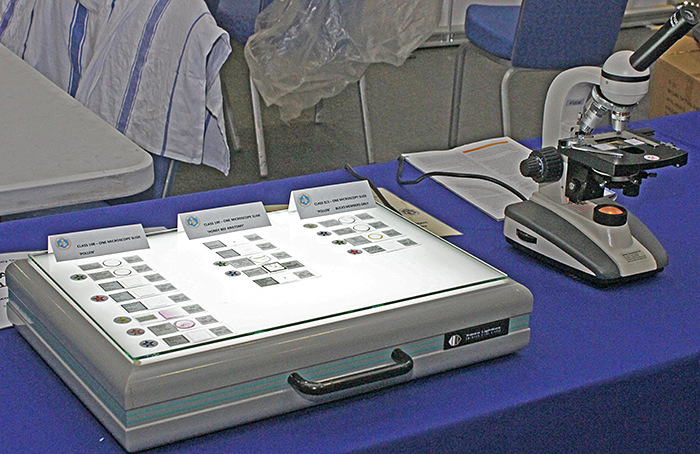 Slide competition
Slide competition
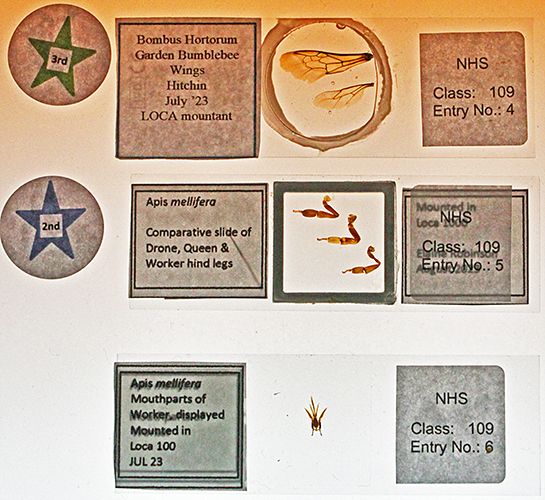 Slides
Slides
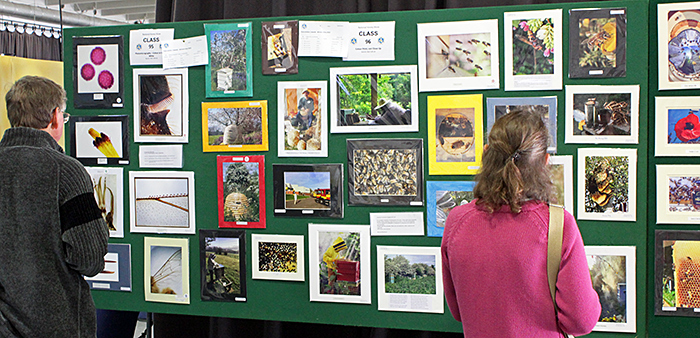 Photography competition
Photography competition
Trade Hall
In addition to the Quekett stands, there were lots of stands in the Trade Hall where members of the public could buy almost anything a beekeeper could desire (except a microscope), browse books on bees, find out about associations to join, learn about beekeeping in developing countries and learn about pests and diseases of bees.
The National Bee Unit is part of the Animal & Plant Health Agency, which works to safeguard animal and plant health for the benefit of people, the environment and the economy. They are involved in the management and control of bee pests and diseases, along with training and dissemination of information to beekeepers. At the Show they were offering advice on problems such as the Asian hornet (Vespa velutina), the small hive beetle (Aethina tumida), European foulbrood, parasitic Tropilaelaps mites, and Varroa mites.
The BBKA represent the interests of beekeeping associations at government level, and facilitates a nationwide educational structure supported by a common examination process.
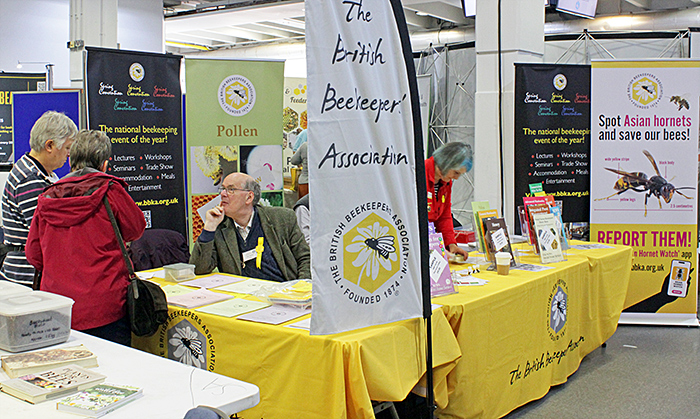 British Beekeepers Association
British Beekeepers Association
Northern Bee Books were selling an amazing number of new books on honeybees, and a good selection of used books.
Bee Craft not only publish BeeCraft Magazine, they also publish books, including “Practical Microscopy for Beekeepers” by Quekett member Bob Maurer.
Bees for Development is a charity that makes life better with bees. They promote sustainable beekeeping to combat poverty, build resilient livelihoods and benefit biodiversity.
Meadow In My Garden sells a range of award-winning flower meadow seed products designed to foster a wildlife-friendly environment, and gives talks and seminars for horticultural clubs, beekeepers groups, garden shows, festivals, green events, civic societies, colleges and schools.
The Woodland Trust is a charity that plants woods and trees, restores damaged ancient woodlands, saves woods and trees from destruction, and cares for over 1000 woods. They work with farmers, landowners and local communities to create bigger, better, more resilient landscapes across the U.K. for people and wildlife.
Claire Murthy is an artist who paints, illustrates and writes about the wildlife and pets that live in and around the garden, countryside and woods. Bees feature in several of her works. She showed some of her paintings, and promoted her latest book, Izzie Lizzie Busy Bee.
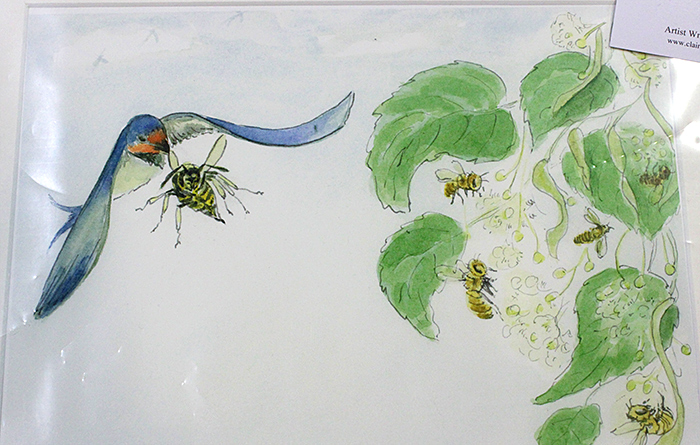 Painting by Claire Murthy
Painting by Claire Murthy
Grans on the Make raise money for charity through their obsession with knitting and crochet, and they showed lots of bee-related items that they have made. Patterns for crochet bees and other items are available on their Make a Beeline website.
There were also stands selling beehives, protective clothing, jar fillers and probably everything else that a beekeeper could want.
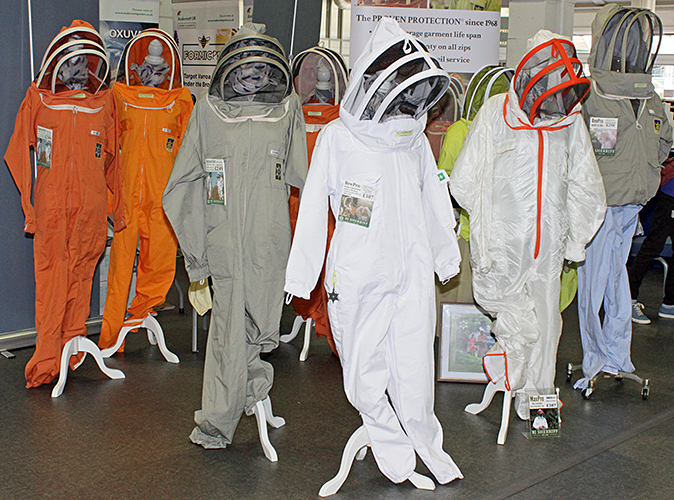 Protective clothing
Protective clothing
Workshops
The Show includes workshops on a wide range of topics, including three on microscopy by Sean Stephenson (Bee anatomy slides, Pollen slides, and Disease testing and abdominal dissection), one by Claire Murthy (Draw and paint bees), one by Marin Anastasov (Honey bee anatomy) and one by Chris Park (Skep making).
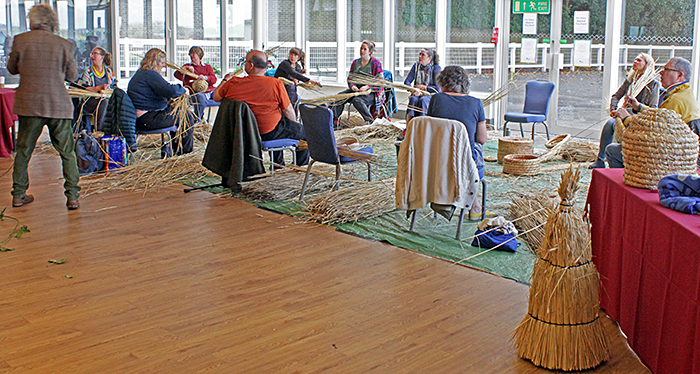 Skep making workshop
Skep making workshop
The next National Honey Show will be held at Sandown Park Racecourse from Thursday 24th to Saturday 26th October 2024, and we are planning to be there again.
Report and most photographs by Alan Wood


